You kind of want a creamy spread, but also kind of want orange marmalade. Get the best of both worlds with this easy to make homemade orange curd recipe!
Originally published October 13, 2021, updated on 4/19/2023

The sunny, wonderful flavor you get from the different types of oranges might be my favorite way to perk up all kinds of recipes - sweet or savory.
Good thing that an abundance of sweet oranges are available year-round!
Anyway, today I’m sharing another homemade citrus curd - my easy orange curd recipe.
Fresh orange curd is something that's easy to make, tastes great... but is notoriously difficult to get right.
Due to the lower acid level of oranges - as compared to lemons and limes - it has a tendency to not set up right. You need enough acid to react with the proteins in the egg yolks, to ensure a nice, thick product.
In my early days of making fruit curd recipes, that meant supplementing the orange juice with some lemon juice - the traditional method for bolstering the acid content in non-lemon curds.
1. The flavour of the orange is diluted with the flavour from the lemon.
2. The acid that the lemon juice brings is diluted with the less acidic orange juice... so it still doesn't set up quite as thick as lemon curd.
A while back, I was working on something completely unrelated, and had a bit of an epiphany: What if I made orange curd with just oranges - no lemon - but brought in additional acid in the form of citric acid?
... and it worked perfectly.
This homemade curd is still a super easy recipe to make - much like a traditional lemon curd recipe.
Like lemon curd, this delicious recipe also requires some specifics with regards to ingredients, equipment, and technique... so let's get to it!

Uses for Orange Curd
Beyond a “just eat it with a spoon, straight from the jar”, there are many, many different uses for orange curd!
Here are a few ideas for you:
- On the breakfast table, or as part of an afternoon tea goodies spread. Spread it on toast, Biscuits, scones, etc. Spoon it over waffles or pancakes (especially good when topped with berries!)
- As a filling for baked goods. Fill Macarons, Cream Puffs or Profiteroles, pre-baked tart shells, with orange curd, or use it as a cake filling for layered cakes*.
- Orange curd is also a great option for Butterfly Cupcakes, either instead of or in addition to frosting. When “in addition to”, I’ll spoon some curd in the cavity, then pipe frosting over it.
- Use as a topping for Pavlova. I like to do the layer of whipped cream, then the curd, and finally the fruit topping. You can even mix some into the whipped cream to flavour it. Orange curd + whipped cream gives a perfect balance of flavours and textures to build on!
Alternately, it’s great as an offering on a Pavlova Dessert Board.
- Spoon it over ice cream, Cheesecake, or crepes.
- We like to drizzle it over yogurt that’s been topped with my Porter’s Yogurt and Ice Cream Topping.
- You can also make layered parfaits with curd and yogurt, or curd and cottage cheese.
* When filling layered cakes with curd, it’s best to pipe a ring of frosting around the outer perimeter of the layer being filled, then fill the inside of that border with the curd.
This gives some stability to the filling layer, and will prevent the curd from oozing out.

Tips for Making Orange Curd
Orange Curd Ingredients
For the most part, this recipe calls for simple ingredients that are easily found in most grocery stores: Orange juice, orange zest, sugar, eggs, and unsalted butter.
A few notes:
1. Be sure to use fresh oranges, not bottled orange juice. It really does not turn out as well when using bottled!
2. You can use any type of oranges you like for this. I'll usually go with some form of clementine or tangerine, but you can use regular navel oranges, valencia, cara cara oranges, even blood oranges.
Go with whatever’s available, and the orange flavor you like best!
3. Use basic white granulated sugar for the best taste.
4. Also, for the best results, use nice fresh eggs.
I use egg yolks, rather than whole eggs. I just find it makes for better flavour and texture. As far as the leftover egg whites go, I like to use them for Swiss Meringue Buttercream, Meringue Cookies or Pavlova.
Citric acid.
We initially started buying citric acid for use with our Homebrewed Ciders and Wines (along with Acid Blend), but over the years, we've been using it a lot more in our kitchen.
You can find it used in such things like my replica Beep Drink, as part of the fun rim on my Fuzzy Peach Candy Cocktail, and as part of my Wine Slush Mix - always a favourite for gifting!
Citric acid is the “secret” ingredient to providing enough acid for the curd to set up, without diluting the flavour of the curd.
Oh, and as an optional ingredient: Food colouring.
Orange curd can turn out very pale, I like to give the colour a bit of a boost! A bit of coloring can take it from looking like lemon curd, to having a beautiful color of its own.

Orange Curd Equipment
You don’t need a ton of equipment to make curd, but each piece you do need is important. Here’s the rundown:
A Zester
First off, you want some way to get the zest off the orange.
When I photographed this, I was using a little zesting plane that I’ve had forever, and it works well. No idea where I got it or what brand it is, though.
Since then, I treated myself to a Kitchenaid Box Grater, and I LOVE it.
If you’re in the place I was - with a 10+ year old basic metal grater that was caving in on itself, didn’t do a great (grate? LOL) job, and was literally being held together with an epoxy job*, seriously... treat yourself to a really good grater.
I had no idea what a difference it would make!
* Ok maybe even if yours isn’t being held together with an ugly epoxy job. Don’t let things get as bad as I did, before deciding it was time to replace. Life is too short!
A Juicer
Next, you need a good way to get the juice out, I prefer using small, citrus-specific juicers for this, rather than the big contraption we have for juicing everything else.
I have a Cuisinart Pulp Control Citrus Juicer, love it, no complaints at all.
There are also the Manual citrus juicers, or the Squeeze-type citrus juicers.
Go with whichever you prefer, just get the juice and avoid the seeds!
Mini Food Processor OR Fine Wire Strainer
You’ll want one or the other - more on that in a bit!
Heavy Bottomed Pot OR Double Boiler
Personally, I prefer using a heavy bottomed pot, but a double boiler is the traditional way to do this... more on that in a bit!
A Silicone Whisk
Yes, wire whisks are great in general... but they can react with the acid in your orange curd, and make it taste metallic.
I like to avoid that whole thing, and just use a silicone whisk.
When making curd, I use the smallest whisk in my Set of 3 Silicone Whisks.
I just find that the smaller one is best to keep everything moving, and prevent clumps - key to making a silky curd.
That said, any brand of silicone whisk should do just fine.
A Thermometer
For both proper thickening AND food safety reasons, I like to use a thermometer when making fruit curds.
You can use any thermometer that will accurate read a temperature of 165 degrees F.
A candy thermometer or instant-read thermometer are both good things to have on hand in the kitchen.
Personally, I like to use a Infrared Cooking Thermometer. It's quick, easy, and no-mess - the best way to keep track of the temperature, IMHO!

Cooking Technique
While you’re “supposed” to cook this over a double boiler - and I did in the photos - I’ll be honest... I never do.
I like to cook my orange curd over low ish, direct heat. I whisk it constantly, and it’s ready in just minutes - so much less fussy.
If you’re not cooking it over higher heat (I wouldn’t go higher than medium heat) and you keep an eye on it / keep whisking, you’re not going to end up with clumps.
I like to use a heavy bottomed pot, for the best heat distribution.
You’ll find that when you start out, there will be a lot of foaming. As you approach the right temperature, that foaming will subside - that’s when you should really start keeping an eye on the temperature, to avoid overcooking it.
Finally, just know that the curd will thicken more as it cools, so don’t be so worried if it’s not as thick as you’d like.
If you followed the recipe, did the spoon trick (more on that later), and your curd reached 165F, it’ll thicken!

To Strain or Not to Strain
Traditionally, orange zest is used in the cooking process, then strained out afterwards.
Personally, I prefer the method I demonstrate here, as well as in my posts for other citrus curds:
I run the zest through my Mini Food Processor, along with the sugar.
This breaks up the zest to bits that are so fine, they’re basically undetectable in the resulting smooth curd.
Not only is this less fussy, I find it tastes better.
That said, you can always zest the orange and not strain at all - the curd just won’t be quite as smooth. Sometimes this is a fun option - I think it’s got some ~ character ~!
Or, if you want smooth and traditional, just press your cooked curd through a Fine Mesh Wire Strainer, before adding the butter.
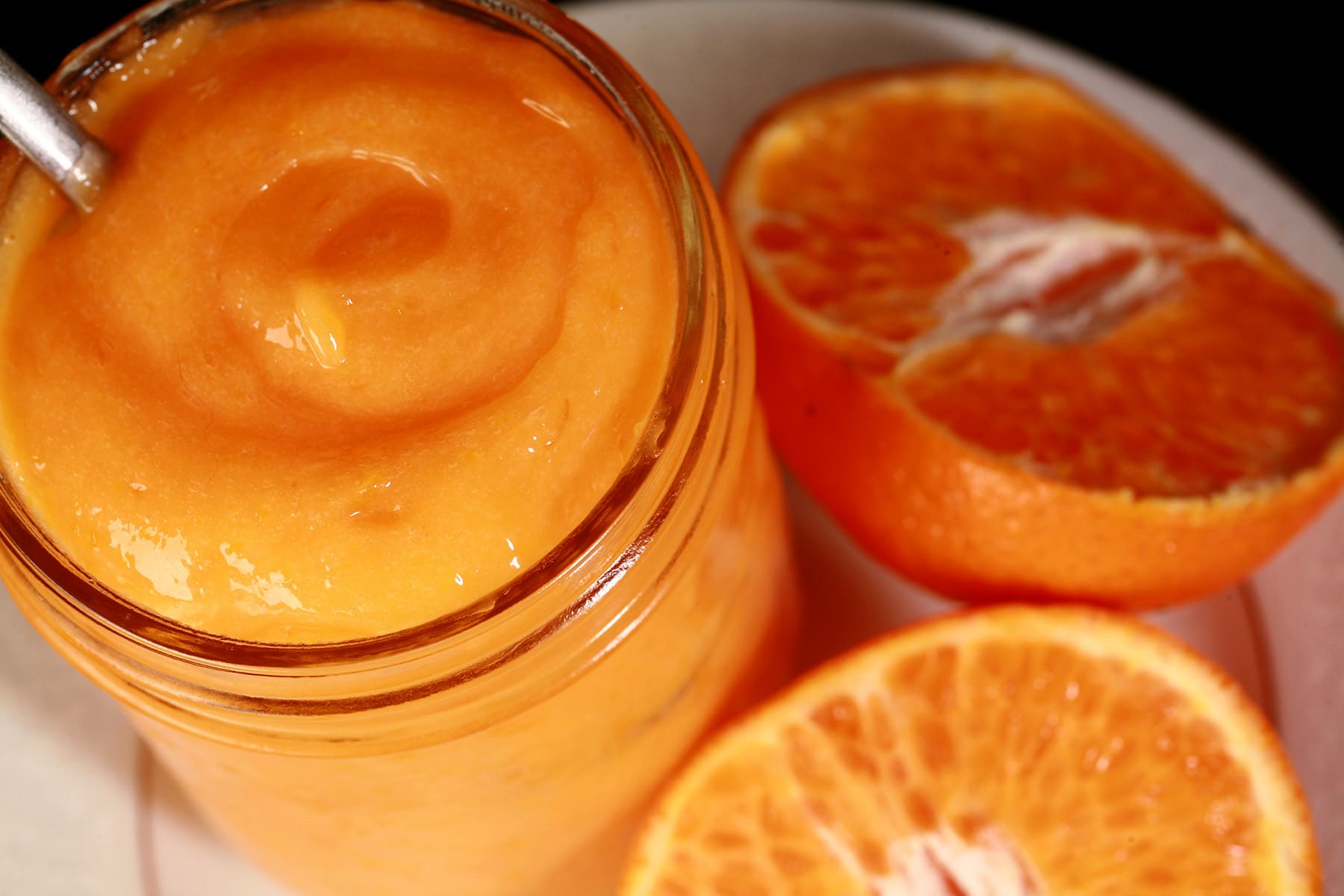
How Long Does Orange Curd Last?
Depending on who you ask, homemade orange curd will last up to a month or two in the fridge. (For food safety reasons, ALWAYS refrigerate your curd - you can’t store it at room temperature!)
Personally, I find it’s best to use it up within 2 weeks, for the best flavour. Keep it in an airtight container.
If the container has a lot of head space, I like to press a piece of plastic wrap against the surface of the curd, to prevent a skin from forming.
Can I Freeze Orange Curd?
Yes! It’ll keep for about 6 months in the freezer, and you can freeze it right in a canning jar.
Freeze your curd as fresh as possible - ie, don’t wait til it’s about to go bad.
When you want to use it, let it defrost in the fridge for a day or two before use.
Once the orange curd is thawed, you’ll want to use it within a week or two.

How to Make Orange Curd
The full recipe follows - in the recipe card at the end of this post - but let's start with the pictorial overview!
Zest the oranges, using the orange part only - the white pith is bitter and should be avoided.

Add the zest and sugar to your mini food processor, blitz until zest is finely chopped and well incorporated in the sugar. Note: See post for details on skipping this step.

Juice your orange(s), measuring out ⅓ cup of the fruit juice.

In a small pot, whisk together egg yolks, large egg, and orange sugar until well combined.
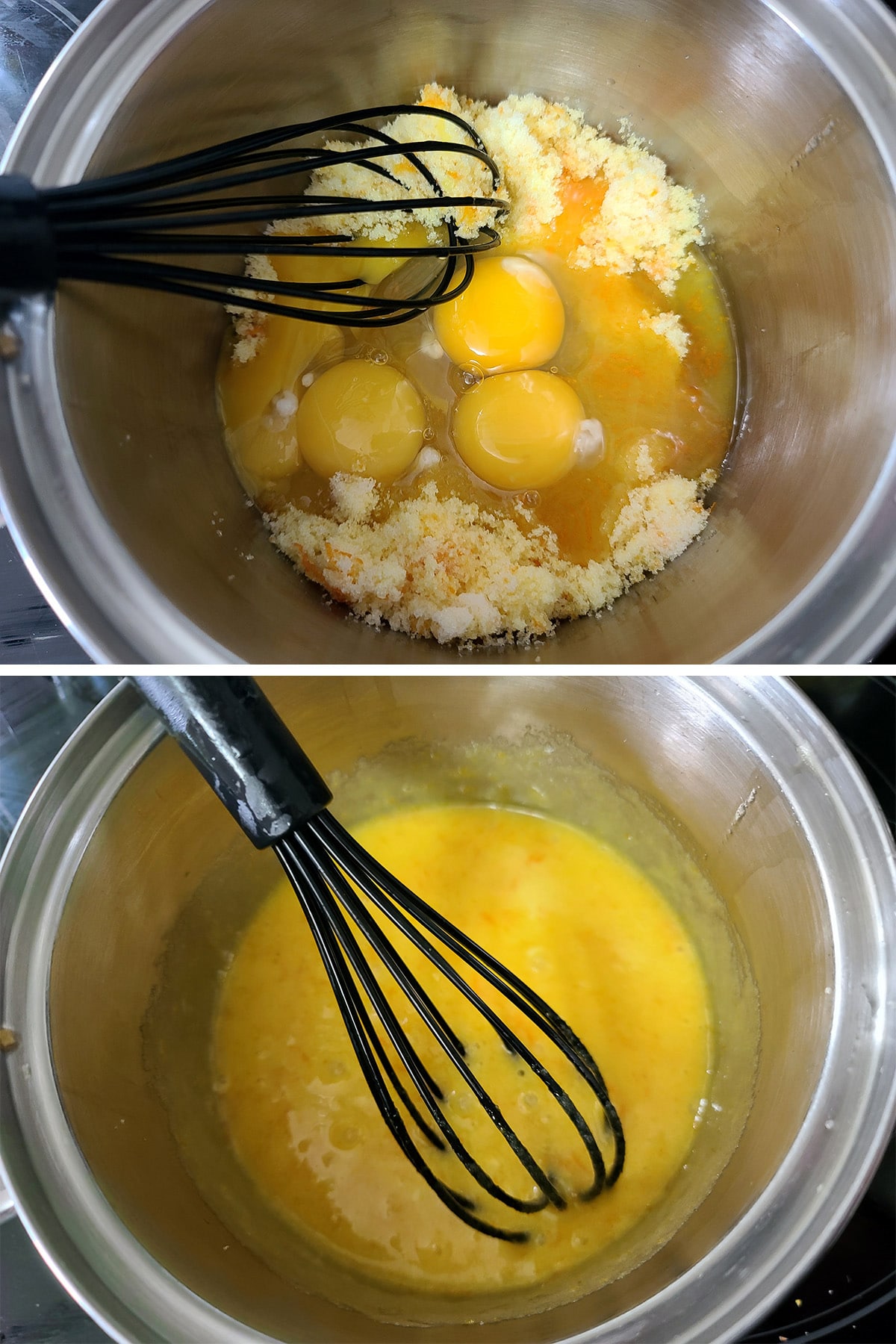
Add the ⅓ cup of orange juice and the citric acid, whisk until well combined.

Cook over medium- low heat, whisking constantly until mixture thickens.

Ideally, you want the mixture to reach 165F - I use a surface thermometer for this.

Once the mixture is thick/hot enough, transfer to a heat proof mixing bowl. Add the pieces of cold butter, whisking until well incorporated.

Once all of the butter melts and been fully incorporated into the curd, tint orange with food colouring, if desired.
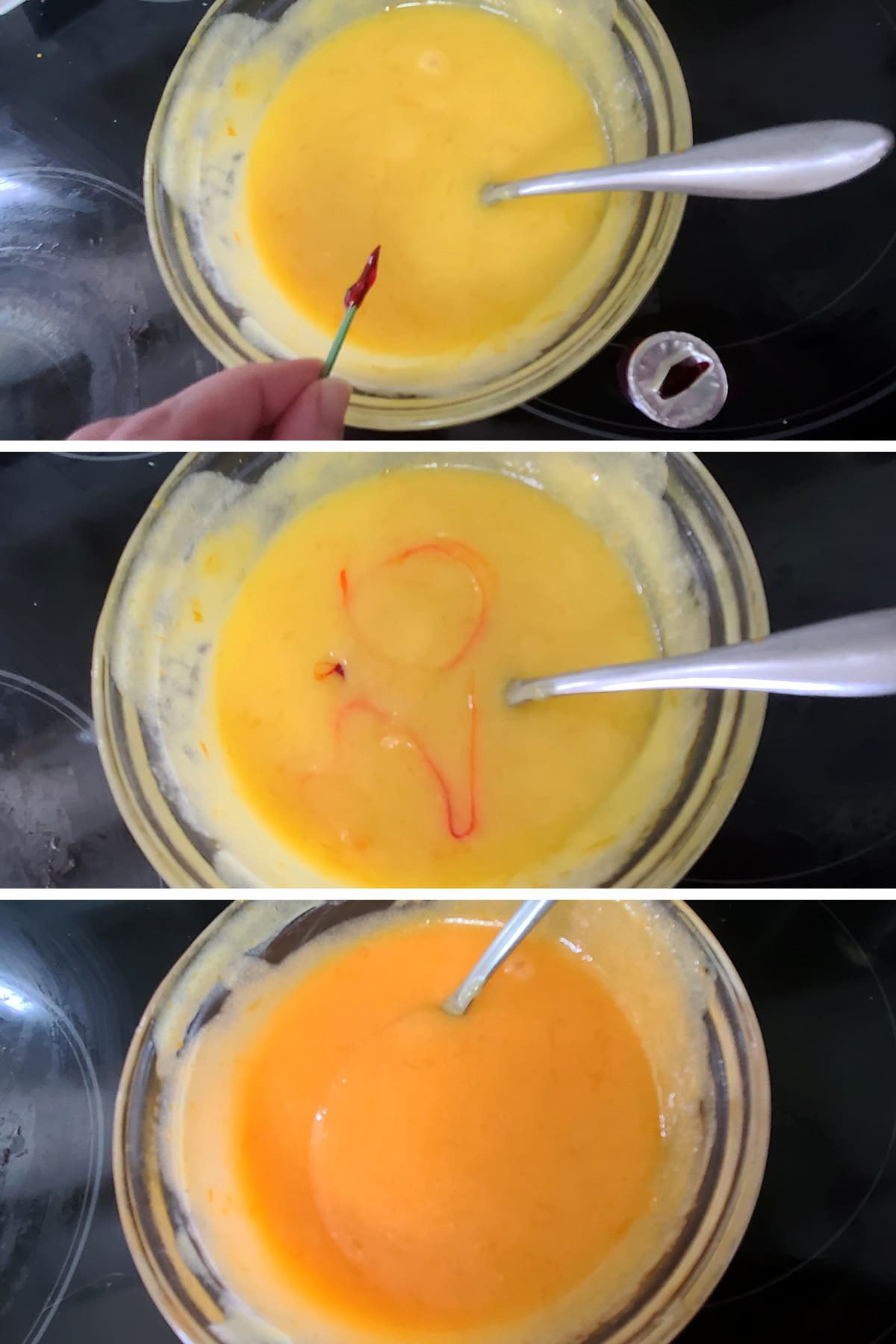
Transfer orange curd to your storage container and chill for at least 1 hour before use.
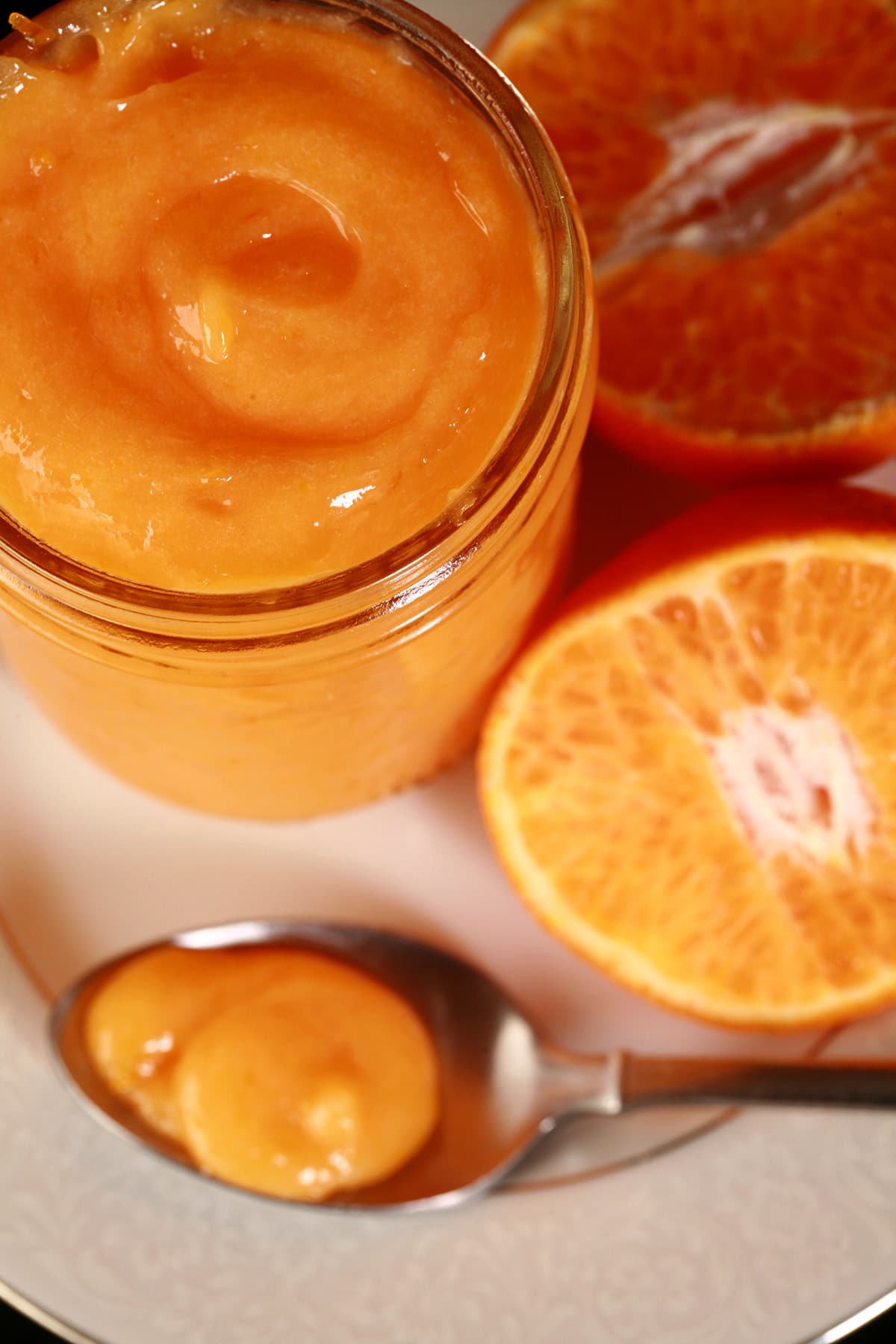
More Fruit Curd Recipes
Looking for more fun fruit curd recipes to dress up your breakfasts, brunches, or desserts? I've got you covered!
Blackcurrant Curd
Blueberry Curd
Cranberry Curd
Grape Curd
Grapefruit Curd
Keto Lemon Curd
Kiwi Curd
Lemon Curd
Lime Curd
Mango Curd
Passionfruit Curd
Raspberry Curd

Share the Love!
Before you chow down, be sure to take some pics of your handiwork! If you post it to Bluesky, be sure to tag us - @CelebrationGen. We're also on Pinterest, so you can save all your favourite recipes to a board!
Also, be sure to subscribe to my free monthly email newsletter, so you never miss out on any of my nonsense. Well, the published nonsense, anyway!
Finally, if you love this recipe, please consider leaving a star rating and/or a comment below, and maybe even sharing this post on social media!
Orange Curd
Equipment
- Zester
- Juicer
- Mini Food Processor
- Silicone Whisk
- Infrared Surface Thermometer
Ingredients
- 1-2 Oranges Any variety
- ¾ cup Granulated Sugar
- 3 Large Egg Yolks
- 1 Large Egg
- ¾ teaspoon Citric Acid
- 6 tablespoon Salted Butter Chilled and cut into pieces.
- Orange food colouring Optional
Instructions
- Zest the oranges.
- Add the zest and sugar to your mini food processor, blitz until zest is finely chopped and well incorporated in the sugar. Note: See post for details on skipping this step.
- Juice your orange(s), measuring out ⅓ cup of the juice.
- In a small pot, whisk together egg yolks, large egg, and orange sugar until well combined. Add the ⅓ cup of juice and the citric acid, whisk until well combined.
- Cook over medium heat, whisking constantly, until mixture thickens. It should be able to coat the back of a spoon and retain a clear trail when a finger is dragged across the back of the spoon. Ideally, you want the mixture to reach 165F - I use a surface thermometer for this.
- Once mixture is thick / hot enough, transfer to a bowl. Add the pieces of butter, whisking until well incorporated.
- If you want to strain the curd, press it through a metal strainer at this point.
- Once all of the butter has melted in and been fully incorporated into the curd, tint orange with food colouring, if desired.
- Transfer orange curd to your storage container and chill for at least 1 hour before use.


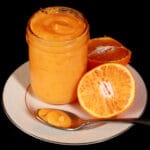

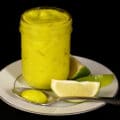


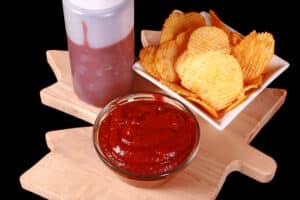



AMITA
Hi, can we make fruit curd without eggs. If yes pls share recipe as I look fwrd to make. Thanks. Pls reply. Amita.
Marie Porter
You could make something similar to a pudding if you used corn starch, but it wouldn't be a curd.
Laura Bradshaw
Hello ☺️ Can we substitute the fresh orange juice and citric acid by using a store bought fresh squeezed orange juice? The store bought has the citric acid all ready in it. Thanks for reading ☺️
Marie Porter
You'd still want to use some citric acid with it - you need it to be as acidic as fresh lemon juice. I don't know how much citric acid is used in store bought orange juice, but it's definitely not THAT acidic!
Laurie
I used Satsumas and the curd turned out beautifully! Thanks for the citric acid hint.
Les
I was thinking of using citric acid in my orange curd recipe. I was wondering, will it add that lovely hit of sour that you get in a lemon curd? Many thanks.
Marie Porter
It does!
Lisa P
Hi, Marie - thanks for the recipe and the chemistry! I’m now the proud owner of a bag of citric acid. I wanted more yield than 1.5 cups so upped the juice a bit, one more whole egg. Two teeny dots of red food coloring and got away with it. 🙂 May be a little runny (result of my choices) but otherwise it’s awesome. I’ve only made lime curd before this, and it was interesting to do the ingredients in about the reverse order with your recipe - it *was* quicker! Will mostly be flavoring yogurt with it. Cheers! Lisa
Vanessa
I have used several of your recipes, and they turn out wonderfully! I used this one with blood oranges, and OMG!!! Just wondering, if I want to make this a little thicker, such as to pipe into a macaron filling, I've read that more yolk and less white will do the trick, or a little corn starch. Have you experimented with those to see the different consistencies? Thank you!!!
Marie Porter
I'd add a yolk and a little more citric acid, and see how that goes. I'm not a fan of corn starch - that's more of a pudding, than a curd.
Tree
How about a guava curd recipe?!! Thanks
Marie Porter
I'll definitely consider it!
Toni McCormick
Hi Marie, just made your orange (with blood aka red oranges). I went for a "Negroni" curd flavor so added some Campari @ appr. 1/2 teaspoon--needed more. I also would prefer a little more tartness--the orange curd is rather sweet. I plan on using it for this recipe https://gardenandgun.com/recipe/summer-strawberry-pie
(I've made several times) the lemon curd is a bit tart so fingers crossed this "negroni" curd will work. I sub out the jelly in the recipe with ROSE jelly--its fab!